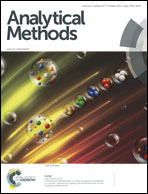Application of Fourier transform near-infrared spectroscopy to the quantification and monitoring of carbonyl value in frying oils
Abstract
A rapid and convenient method for determining carbonyl value (CV) in frying oil using Fourier transform near-infrared (FTNIR) spectroscopy was established. A total of 144 oil samples were subjected to CV determination using the 2,4-dinitrophenylhydrazine (2,4-DNPH) method and FTNIR spectroscopy combined with partial least square (PLS) modeling. The PLS model worked best with pretreated spectra in the wavelength range of 9702 cm−1 to 4531 cm−1, resulting in a root mean square error of calibration (RMSEC) of 1.47 mmol kg−1 and prediction (RMSEP) of 1.73 mmol kg−1. Studies related to the monitoring of CV changes in a simulated frying process of oil samples were then performed to evaluate the feasibility of the method for online monitoring of oil quality. Results showed that the model-predicted value was close to the true value determined by the 2,4-DNPH method (R = 0.989). Therefore, the FTNIR method can be used for quantifying and monitoring CV with the advantages of simple operation and no pollution.


 Please wait while we load your content...
Please wait while we load your content...